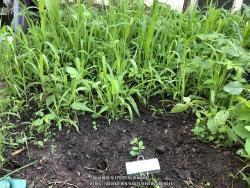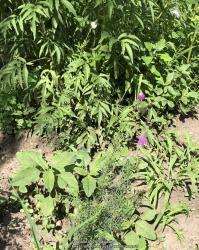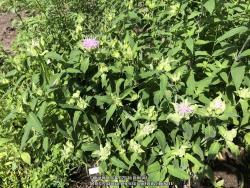Posted on Jul 4, 2020 2:47 PMSomething Old...
I was able to spend some time this weekend in the garden. For the most part, this was routine maintenance, involving watering plants and pulling occasional weeds. But I also made a dent in the East bed, which was overrun with weeds. Fortunately, I was able to find my plants underneath. I also found lots of hoof marks from deer, so I expect they saw the lush weed growth as something tasty. My New England Asters (Symphyotrichum novae-angliae) got their tips munched some days ago, but have recovered quite well.
You can see from this picture just how high the weeds got. I'd cleared out the White Wild Indigo (Baptisia alba), which is the small plant behind the metal label. There are four more hiding in the jungle behind it. I can't see them, either.

I'm also revelling over my Prairie Clovers; I have four, two purple (Dalea purpurea) and two white (Dalea candida). They look amazing and are growing up very well this year; I planted them late last year, and thought they died over the winter. The colors of the blooms are wonderful. You can see both in this photo.

The Swamp Milkweed (Asclepias incarnata) is doing well, also. The existing one has been attracting insects; I even photographed a Monarch butterfly on it! I've seen one several times, but only one at a time, so I don't know if I'm seeing only one butterfly or several. But it is reassuring that at least one Monarch knows where it is.

The first blooms on my Wild Bergamot (Monarda fistulosa) showed up this weekend. They have a delicate scent and a pale lavender color. I don't think I had any blooms last year, so this will be exciting, to see what insects are attracted to it.

For the Birds
One of the big maintenance activities this weekend was refilling the feeders. Remember, the whole point of me getting into gardening was to make it more appealing to birds. So, providing food for the birds is important. Take a look at this panorama:

Here's a key to what you are seeing in the photo, numbers corresponding to those in the photo, from left to right:
- First pole: Hummingbird feeder and woodpecker suet feeder.
- Second pole: Hopper feeder.
- Third pole: Original hummingbird feeder, tray feeder, and meal-worm feeder.
- Fourth pole: Finch feeder, Baltimore Oriole feeder, and peanut pick-outs feeder.
- Fifth pole: Fly-through feeder.
- Squirrel corn feeder.
- Sixth pole: Squirrel feeding station.
- Suet feeder hidden on other side of tree.
Why so many? Well, let's talk about what these are all for.
First Pole: Hummingbird Feeder and Woodpecker Suet Feeder
The hummingbird feeder here is the second one; the original one is on the third pole. But Ruby-Throated Hummingbirds, the species we get in Minnesota, are very territorial. There was one time, last year, when I saw two at once, and one chased away the other. So I put in this second feeder in hopes of giving any additional hummingbirds a chance. I have yet to plant my hummingbird garden; a lot depends on how well I do at maintaining my existing planting areas.
The woodpecker suet feeder has a wooden matrix, so that a woodpecker can cling below the cage which holds the suet. In the winter, I saw this used several times, but it hasn't gotten as much attention in warm weather as the suet feeder on the Colorado Blue Spruce (#8 in the photo).
Second Pole: Hopper Feeder
I had this feeder for a long while, and many species seem to prefer it. I don't have a tall pole for it yet, so it is on a shorter plant-hook. This has a "songbird" or "cabin" mix in it, with many seeds in the shell, sometimes with dried fruit. Squirrels can get to this, so it often needs to be refilled.
Third Pole: Original Hummingbird Feeder, Tray Feeder, and Meal-Worm Feeder
The hopper feeder used to be here, but I switched to the tray feeder because bigger birds -- grackles and mourning doves -- were unable to easily get to the food.
The original hummingbird feeder I put up in the spring of 2019. I'd never had hummingbirds in my yard before (that I know of), but I did get a couple, at least, after putting this out. Hummingbird nectar is easy to make at home, and you do have to clean the feeders periodically, so the nectar doesn't go bad and make the hummingbirds sick. They might visit the feeder several times in a day. Sometimes they will sit at the feeder, and other times they will perch on the dead branches of the Colorado Blue Spruce trees in the yard.
The meal-worm feeder is a metal mesh cylinder holding freeze-dried meal-worms. Many birds want to eat this in the spring. I've had days where I filled the feeder in the morning and it was empty by the end of the day.
Fourth Pole: Finch Feeder, Baltimore Oriole Feeder, and Peanut-Pick-Outs Feeder
This pole is fairly far away from the others, and that's because I originally got it for feeding Baltimore Orioles. These orange-and-black birds are somewhat shy, so they won't come close to the house, or busier feeders. The Baltimore Oriole feeder has two spikes for orange halves -- though I've never seen an oriole eat from any oranges I put out -- and two little dishes. Orioles also will drink nectar, though it isn't as concentrated as the mix used for hummingbirds. But Baltimore Orioles
love grape jelly! So I use one dish for that. The other dish I've used for nectar without much luck, but starting in June, orioles seek out another food:
live meal-worms. So I'll put some of those in the other tray, with some carrot peels (the worms are really insect larvae and will eat these). They get eaten up in a few days.
I stuck the finch feeder out here since it doesn't get used too much, and when it does it is usually a different time of day than when Baltimore Orioles arrive. The peanut pick-out feeder is one I picked up at a church silent auction, and I figured providing unshelled peanuts would be good: It gets visited by woodpeckers, cardinals, and black-capped chickadees.
Fifth Pole: Fly-Through Feeder
I got this as my first feeder last year. It is large, with a roof over it. The idea is that ground-feeding birds will eat here; mourning doves and some sparrows certainly qualify. Robins, on the other hand, stick to the ground because they are going for worms.
This one is closest to the dining room windows, so I could do bird counts in the winter. All other feeders are visible from those windows, too, for the same reason.
Squirrel Corn Feeder
This is one of the first things I put into the yard, decades ago. When we moved in, there were three albino squirrels, so I wanted to keep them around. I got a feeder that let you screw on dried corn-on-the-cob onto a hub, which would spin. Squirrels don't seem bothered by feeding while hanging upside down.
I had to replace the hub when it wore out, but the squirrels still go for corn. I have to weed out corn plants quite often!
Sixth Pole: Squirrel Feeding Station
This is the original, hopper-style bird feeder that came with the house. It was in the middle of three Colorado Blue Spruce trees. Squirrels were easily able to jump to it -- they can generally jump to something that's within ten feet of a tree or building -- but I would still put out suet and bird seed. When I started the bird watching last year, I found out that it was better to let the squirrels have their own place. This is now filled with a "critter" crunch mix, and one of the baskets for suet I now fill with in-the-shell peanuts, which squirrels and blue-jays love. Squirrels will eat suet, so I'll still use a basket for that.
Suet Feeder Hidden on Other Side of Tree
I added a suet basket on one of the spruce trees, to benefit woodpeckers. They definitely seem to prefer it, but they will get peanut pick-outs, use the other suet feeders, and sometimes nuts from the other feeders I have. Gray cat-birds will also eat this suet, and squirrels will nibble on it when they want fats.
...Something New
The big change this week, which will probably delay my next blog post, is that I'm off to the Mayo Clinic this week. When I get back, I won't be able to putter in my garden for a week or so. This all relates to some of the health issues to which I referred in earlier blog posts. Hopefully, things will be better.
My main goal is to write instructions for my family so that they know what to weed, water, and feed out in the yard while I'm gone!




